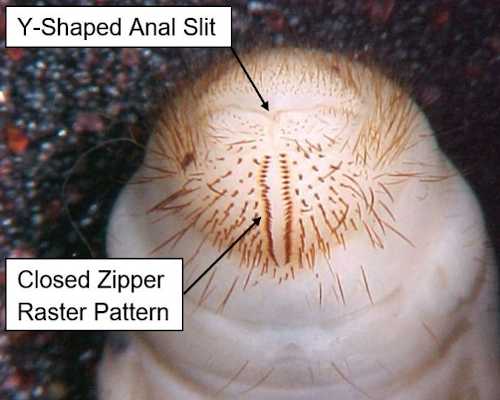By Christian Tollini
White grubs are a very common pest of turfgrass, causing damage to lawns and golf courses all over Michigan. White grubs can be a pest in many field crops as well, affecting crops such as corn, small grains, soybeans, potatoes and forage crops.
White grubs are the larvae of several different species of scarab beetles. June beetles, Japanese beetles, European chafers, Asiatic garden beetles and Aphodius (manure) beetles are all species whose larvae have been associated with damage in Michigan field crops. White grubs damage crops by feeding on the root hairs or completely severing roots, causing yield losses from stunted crop growth and stand loss.
Identifying the species of white grub present in a field is critical for determining a course of action because different species have different life cycles. June beetles have a three-year life cycle. Adult June beetles lay eggs in the soil in the spring. After eggs hatch in three to four weeks, the larvae will proceed to feed on roots of plants present in the soil. As temperatures cool, the grubs will burrow deeper into the soil to overwinter. As temperatures warm in the spring, grubs return to shallower zones in the soil to feed for another growing season.
Grubs will overwinter again, but in the following spring they will enter the pupal stage and remain in the soil for the rest of the year. Adults emerge from the soil the following spring, mate and will return to the soil to lay eggs, completing their life cycle. June beetle grubs can cause crop damage year-round because larvae feed on crop roots the entire length of the growing season.
Most of the other pest grubs in Michigan have an annual life cycle. Grubs emerge from eggs in mid-summer, larvae feed on crop roots through fall, overwinter in the soil and begin feeding again in early spring. Early in the summer, the larvae pupate and emerge from the soil as adults. Adults will lay eggs in the soil in mid-summer. Crop damage from grubs of these species is typically limited to the fall and spring, ending when adults emerge. A few species, like the Japanese beetle and Asiatic garden beetle, also cause crop damage in their adult stage in the summer by feeding on the foliage of crops.
Grub species can be identified by the raster pattern (a pattern of spines) and the shape of the anal slit. Each species has a unique combination of raster pattern and anal slit shape. Michigan State University Extension entomologist Chistina DiFonzo developed a handy field ID sheet for identifying grub species.

When identifying white grubs, observe the raster pattern and anal slit of the grub. This grub has a Y-shaped anal slit and a raster pattern that resembles a zipper, indicating that it is the larvae of a June beetle.